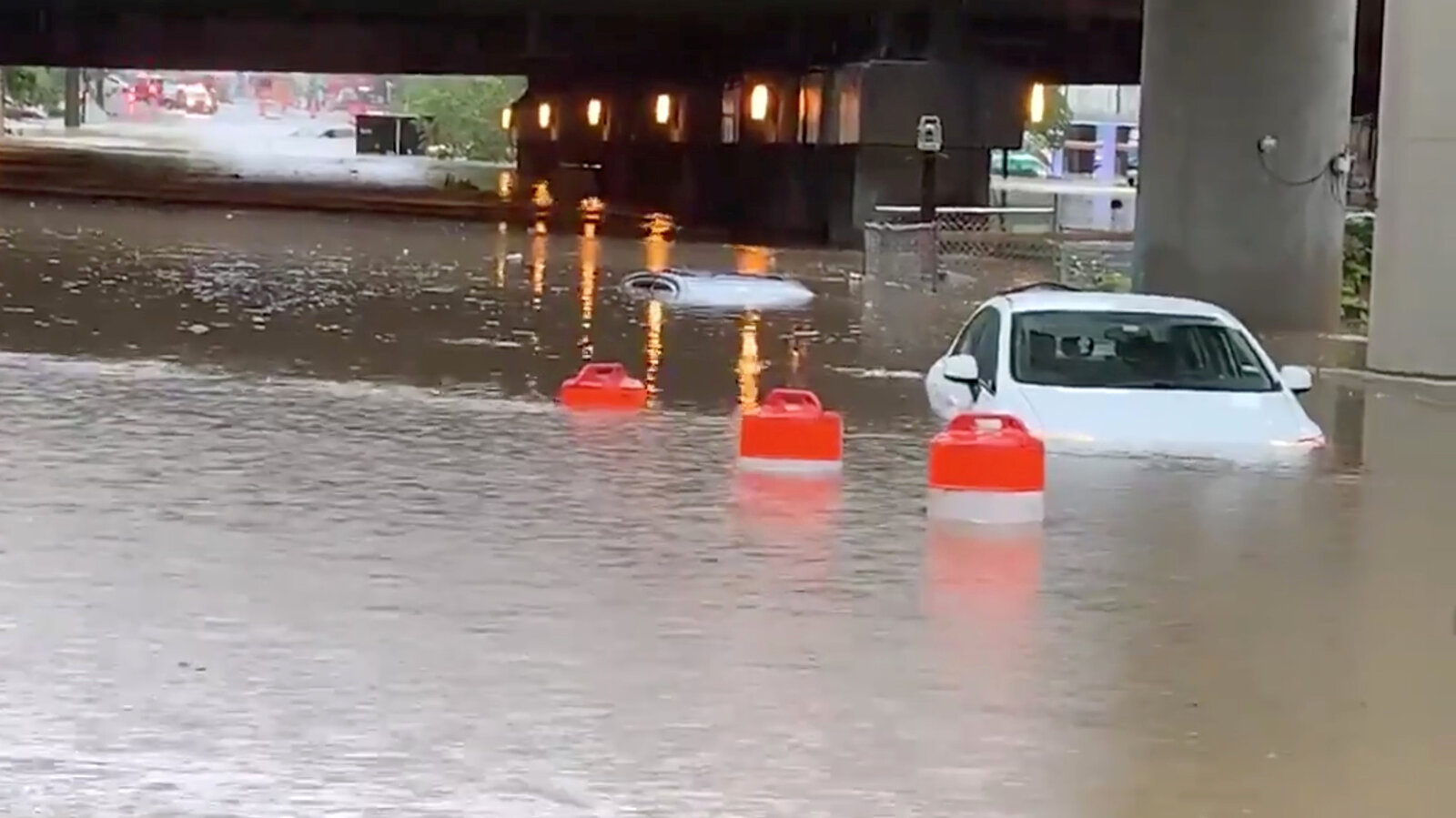What Is A Flash Flood? Understanding Flood Warnings And Alerts

Table of Contents
What Causes a Flash Flood?
Flash floods are typically caused by intense rainfall overwhelming drainage systems, but other factors can also contribute. The sheer volume of water accumulating in a short period is the key element. This intense precipitation can quickly transform normally benign waterways into raging torrents.
- Intense rainfall in a short period: Heavy downpours, often associated with thunderstorms or tropical storms, are the most common cause. The ground becomes saturated, and water cannot be absorbed quickly enough, leading to rapid runoff.
- Sudden dam or levee breaches: Failure of man-made structures designed to control water flow can trigger catastrophic flash floods downstream. This often results in a sudden and overwhelming surge of water with little to no warning.
- Rapid snowmelt in mountainous areas: A sudden and significant temperature increase in mountainous regions, particularly during spring, can rapidly melt accumulated snowpack. This massive influx of meltwater can quickly overwhelm rivers and streams, leading to flash flooding in lower-lying areas.
- Poor drainage systems in urban areas: Urban areas with inadequate drainage infrastructure are particularly vulnerable to flash flooding. Impervious surfaces like roads and buildings prevent water absorption, channeling it directly into storm drains that may be quickly overwhelmed.
- Reiterating the flash flood definition: It's important to remember that the defining characteristic of a flash flood is its speed and the incredibly limited warning time often available. This rapid onset is what makes flash floods so dangerous.
Recognizing the Signs of an Impending Flash Flood.
Being aware of the visual cues that precede a flash flood can significantly increase your chances of escape. These signs are often subtle initially, escalating quickly as the flood develops.
- Suddenly rising water levels in streams and rivers: Notice a rapid increase in water level – even a few inches in a short period can be a significant indicator.
- Overflowing streams and creeks: If normally calm streams or creeks begin to overflow their banks, this signifies an increase in water volume exceeding the capacity of the watercourse.
- Water flowing over roads or bridges: Seeing water flowing across roads or covering bridges should be treated as a serious warning sign, indicating imminent danger. Never attempt to drive through flooded areas.
- Debris accumulation in rivers and streams: An unusual amount of debris, such as branches, logs, or trash, rapidly accumulating in a river or stream often suggests a significant increase in water flow.
- Unusual sounds like roaring water: A sudden increase in the loudness or intensity of rushing water, especially if you don't normally hear that sound, is a clear sign that a significant water event is occurring.
Understanding Flood Warnings and Alerts.
The National Weather Service (NWS) issues various alerts to warn the public about potential or imminent flash flooding. Understanding the difference between these alerts is critical for appropriate action.
- Flash Flood Watch: Conditions are favorable for flash flooding. This means that the weather conditions are such that flash flooding is possible. Stay informed and be prepared to take action if necessary.
- Flash Flood Warning: Flash flooding is occurring or is imminent. This is a serious alert indicating immediate danger. Take action immediately to protect yourself and your property.
- Flash Flood Advisory: Flash flooding is possible. This is a less severe alert than a warning, but it still indicates the potential for flash flooding. Remain vigilant and monitor the situation closely.
- Multiple Information Sources: Rely on multiple sources such as weather radio, NOAA weather apps, local news, and official government websites for the most up-to-date information.
- Signing up for Alerts: Register for emergency alerts through your local government or the NWS. These alerts can be delivered directly to your phone, providing immediate notification of impending danger.
Safety Measures During a Flash Flood.
Your safety is paramount during a flash flood. Act swiftly and decisively when a flash flood warning is issued.
- Evacuate immediately if instructed: If authorities issue an evacuation order, comply without delay. Your life is more important than your belongings.
- Move to higher ground: If evacuation isn't possible, seek higher ground away from flood-prone areas.
- Do not drive through flooded areas (turn around, don't drown): Floodwaters can be deceptively deep and swift, easily sweeping vehicles away.
- Avoid contact with floodwaters: Floodwaters can be contaminated with sewage, chemicals, and other harmful substances.
- Stay informed through official channels: Continue to monitor weather reports and official advisories for updates.
- Secure your property as much as possible: Move valuable items to higher levels and take steps to protect your property from damage.
Post-Flash Flood Actions.
After the immediate danger has passed, there are still crucial steps to take.
- Report damage to local authorities: This helps assess the overall impact and facilitates aid distribution.
- Avoid contact with contaminated floodwaters: Wear protective gear when cleaning up and avoid direct contact with the floodwaters.
- Be aware of potential hazards (downed power lines, unstable structures): Exercise caution when returning to your property, as many dangers might still be present.
- Seek professional help for major damage: Contact qualified contractors for structural repairs and other significant damage.
- Contact your insurance company: Report the damage to your insurance provider as soon as possible to begin the claims process.
Conclusion:
Flash floods are a serious and often deadly natural hazard. Understanding the causes of flash floods, recognizing the warning signs, and knowing what actions to take before, during, and after a flash flood event are critical for ensuring your safety and minimizing potential damage. Heeding flash flood warnings and alerts is not merely advisable; it's essential for protecting yourself and your community. Learn more about flash flood preparedness in your area, develop a detailed flash flood emergency plan, and stay informed about weather alerts to safeguard your family from the dangers of flash flooding. Take control of your safety – be prepared for a flash flood.

Featured Posts
-
 Los Hijos De Alberto De Monaco Celebran Su Primera Comunion
May 26, 2025
Los Hijos De Alberto De Monaco Celebran Su Primera Comunion
May 26, 2025 -
 Live Streaming Moto Gp Inggris 2025 Trans7 Spotv Jadwal And Update Klasemen
May 26, 2025
Live Streaming Moto Gp Inggris 2025 Trans7 Spotv Jadwal And Update Klasemen
May 26, 2025 -
 Buy And Hold Facing The Gut Wrenching Challenges Of Long Term Investing
May 26, 2025
Buy And Hold Facing The Gut Wrenching Challenges Of Long Term Investing
May 26, 2025 -
 Trumps Campaign Against Elite Law Firms Faces Another Defeat
May 26, 2025
Trumps Campaign Against Elite Law Firms Faces Another Defeat
May 26, 2025 -
 Lewis Hamilton And Teammates Name A Moment Of Respect In F1 Testing
May 26, 2025
Lewis Hamilton And Teammates Name A Moment Of Respect In F1 Testing
May 26, 2025
